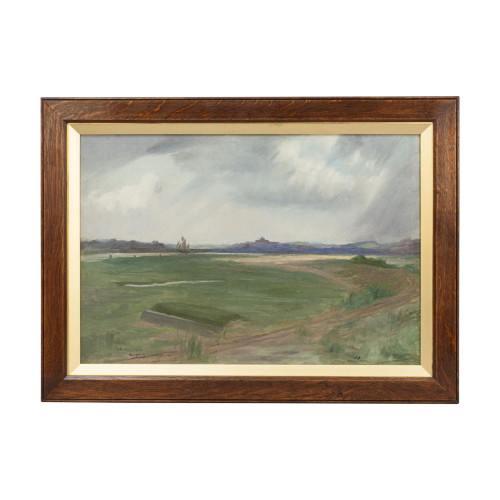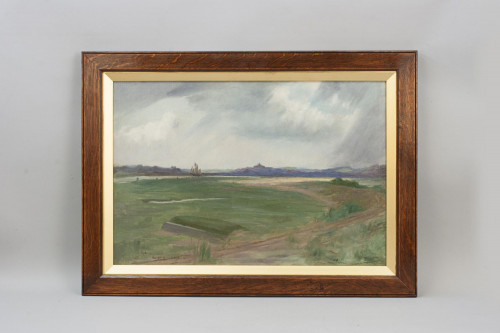- Home
- Golf
- Artwork, Paintings & Prints
- Golf Watercolour, Bilston Golf Club
Golf Watercolour, Bilston Golf Club
Golf Watercolour, Bilston Golf Club
29202
Bilston Golf Club Watercolour, H.E. Lewis Driving.
A charming golf watercolour of H. Lewis (the club professional at Bilston Golf Club) driving from the second tee. Lewis is watch by his three playing companions on his way to the course record for a professional of 61. To the reverse of the golf picture is a title label "The Second Tee, (Bilston Golf Club) H.E. Lewis Driving. An Appreciation Of A Capital Performance" and H.E. Lewis's record score card for Bilston & Willenhall Golf Club. Written in ink on the scorecard "H.E. Lewis, Course Professional Record" and signed by a committee member. The card shows his score of 30 out and 31 in. Lewis was the professional at Bilston Golf Club from 1930 to 35.
Adapted from 'Golf Missing Links' on the web:-
The club first appeared in the early 1920s. A 9-hole course situated in the Proud Lane, Mount Pleasant area. The Great Western Railway station at Bilston was just 10 minutes away. Local hotels were the Villiers Arms, Pipe and the Park Hall.
From 1928 to 1932 the club had a membership of over 140. Visitors' fees were 2/- a day and 5/- a week. In the mid 1930s membership had increased to 160. Visitors' fees were now 1/6 a day, weekend and Bank Holidays 2/6 a day and 5/- a week. In 1936 the course had a SSS and Par of 68. The membership again increased to 175. Course records were, amateur R B Walton 63 and professional H Lewis 61. The club was now licensed.
In 1940 there was a membership of 160. From 1952 to 55 the SSS was now 62. Visitors' fees were 2/- a day, weekend and Bank Holidays 3/- a day, 5/- a week and 12/6 a month. From 1956 to the clubs last year in 1958 the course measured 4626 yards. There was a membership of 100. Visitors' fees were 2/6 a round and 3/6 a day
The following extracts are from Mike Fones book "Skylarks, Sticklebacks, Newts and Golf Balls - An historical review of Bilston Golf Club 1920 - 1956."
In July 1920, having visited land in the Prouds Lane area, the Housing Committee of Bilston Urban District Council decided to offer the land to the newly formed Bilston & Willenhall Golf Club.
In 1921 the task of designing and laying out of a nine-hole golf course on undeveloped wasteland began. The course boundary was marked out with posts and wire fencing. It is reasonable to assume that the initial groundwork was carried out by Mr Freddie Proud the full time groundsman and green-keeper. The course had two fishing pools, the Iron Jack and the Cottage, plus a small shallow pool named the Skeleton.
It is clear that a well organised and well run golf club was established with most members being local wealthy business and professional men and their wives. They could play their golf surrounded by open spaces and be relatively free from the grime and dirt generated by the heavy and light industries approximately one mile away.
1930 was an important year for the club as it secured a twenty one year lease from the Corporation, thereby, giving club officials and members the confidence to invest in improvements and plan for the future.
From 1933/4 the club was known as Bilston Golf Club with no mention of Willenhall.
By 1938 the club had used its first sixteen years to good effect. The course had been developed and refined under the diligence and enthusiasm of groundsman Freddie Proud. He had been provided with good quality mowers and machinery financed by the club's strong financial position. The club competed in the County league and had developed a full range of club competitions for its male and female members. There was also a vibrant and well supported social section.
In May 1938 Norman Jones, assistant professional at Mote Mount Golf Club, London, was appointed professional at Bilston. Norman Jones joined Mote Mount from South Staffordshire Golf Club in the early 1930s.
In 1939 a three point policy was agreed with the Council:-
To replace the wooden clubhouse with a new £2000 brick one that would offer new and high quality facilities. Extend and improve the course layout. Replace the old wooden boundary fencing.
However, with the onset of WW2 such projects were of far lesser importance.
At the end of the war a committee of old members met in a local pub with a view to organising a revival of the club. A loan was arranged and finances raised and within six months the club was back on its feet. By 1949 membership had reached 160.
Had the improvements proposed in 1939 been implemented it is very likely that the course would still exist today, possibly as a Municipal nine-hole course.
Dimensions:
1900-1949
Circa 1930's
Watercolour
England
Good condition, mount with some discolouration
Thank you for your enquiry.
We will get back to you soon.
Please create wishlist to add this item to
RELATED ITEMS































